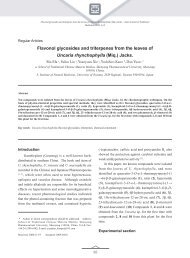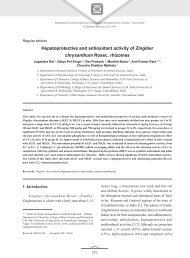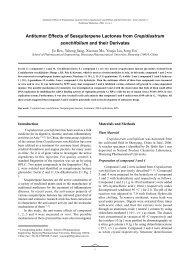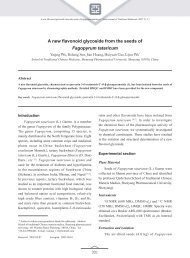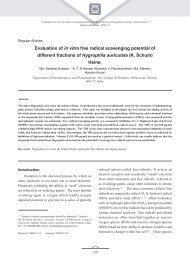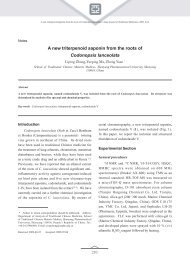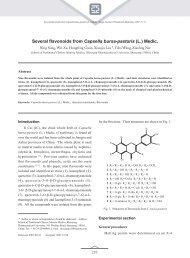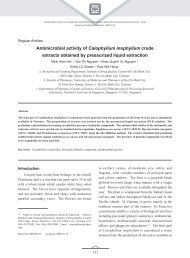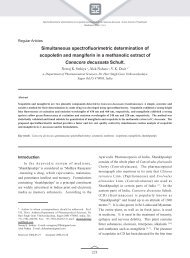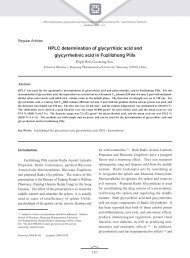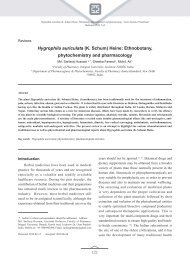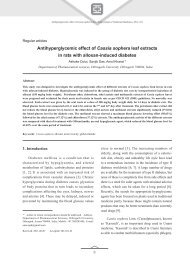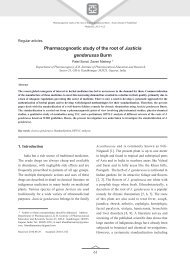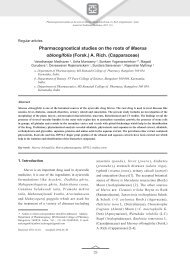Antiviral and Immunomodulatory Properties of Prunella vulgaris
Antiviral and Immunomodulatory Properties of Prunella vulgaris
Antiviral and Immunomodulatory Properties of Prunella vulgaris
- No tags were found...
Create successful ePaper yourself
Turn your PDF publications into a flip-book with our unique Google optimized e-Paper software.
Asian Journal <strong>of</strong> Traditional Medicineseffects, this review will focus on these novel properties<strong>and</strong> future therapeutic potential.<strong>Antiviral</strong> activities <strong>of</strong> <strong>Prunella</strong> <strong>vulgaris</strong> againstHIV-1, HSV-1 <strong>and</strong> HSV-2A number <strong>of</strong> antiviral studies <strong>of</strong> P. <strong>vulgaris</strong> extractshave been carried out <strong>and</strong> active compounds against HIV<strong>and</strong> HSV have been identified (Table 1), especially in itspolar fractions. A 10 kDa anionic sulfatedpolysaccharide called prunellin was found to inhibit thereplication <strong>of</strong> HIV-1 [16] . In addition, the extract <strong>of</strong> P.<strong>vulgaris</strong> demonstrated a significant inhibitory effect onHIV-1 replication with relatively low cytotoxicityin-vitro <strong>and</strong> it was able to arrest the cell-celltransmission <strong>of</strong> HIV-1, prevent syncytium formation <strong>and</strong>interfere with both HIV-1 <strong>and</strong> purified gp120 bindingto CD4 receptors [21] . Similar results have been obtainedin further studies involving the inhibitory mechanism <strong>of</strong>HIV-1 infection in vitro by a purified extract <strong>of</strong> P.<strong>vulgaris</strong> [25] . The polyphenols <strong>and</strong> tannins <strong>of</strong> P. <strong>vulgaris</strong>have been suggested to be the major inhibitors <strong>of</strong> HIV-1gp41 six-helix bundle formation which is a critical stepin the membrane fusion between the HIV <strong>and</strong> its targetcells [17] . Also, it has been reported that an aqueousextract <strong>of</strong> P. <strong>vulgaris</strong> inhibited HIV-1 integrase activity[26] .Previously, anti-HSV activity <strong>of</strong> the aqueous extract<strong>of</strong> P. <strong>vulgaris</strong> has been described [8] . Out <strong>of</strong> one hundred<strong>and</strong> forty two kinds <strong>of</strong> traditional medicines, it has beenfound that the hot aqueous extract <strong>of</strong> P. <strong>vulgaris</strong>selectively inhibited HSV-1 [9] . Xu <strong>and</strong> co-authorsreported that a water soluble polysaccharide componentin P. <strong>vulgaris</strong>, which could be extracted with hot water,precipitated in ethanol <strong>and</strong> then purified by gelpermeation column chromatography, exhibited potentanti-HSV activity. The 50% plaque reduction dose <strong>of</strong> thepolysaccharide for HSV-1 <strong>and</strong> HSV-2 was 10 mg/ml <strong>and</strong>similar inhibitory effects were also exhibited againstacyclovir-resistant(TK-deficient or polymerase-defective)strains <strong>of</strong> HSV-1 <strong>and</strong> HSV-2 [10] . Furthermore, a studyusing the polysaccharide fraction <strong>of</strong> P. <strong>vulgaris</strong> showed areduction in the expression <strong>of</strong> HSV-1 <strong>and</strong> HSV-2antigens in their host Vero cells. Interestingly, thepolysaccharide fraction <strong>of</strong> P. <strong>vulgaris</strong> was also shown tohave an inhibitory effect on an acyclovir-resistant strain<strong>of</strong> HSV-1, ranging from 24.8 to 92.6% at 25-100 mg/ml,<strong>and</strong> it was suggested to have a different mode <strong>of</strong>anti-HSV action from that <strong>of</strong> acyclovir [28] .<strong>Immunomodulatory</strong> effects <strong>of</strong> P. <strong>vulgaris</strong>The immunomodulatory effects <strong>of</strong> P. <strong>vulgaris</strong> havereceived increasing attention in recent years. The keypromising immunomodulatory effects <strong>of</strong> differentextracts <strong>and</strong> chemical constituents isolated from P.<strong>vulgaris</strong> have been demonstrated in different models <strong>and</strong>these are summarized below (Table 2).Table 1<strong>Antiviral</strong> properties <strong>of</strong> <strong>Prunella</strong> <strong>vulgaris</strong> <strong>and</strong> its active components<strong>Antiviral</strong> actions Active components ReferencesInhibition <strong>of</strong> HIV replication Prunellin [16]Prevention <strong>of</strong> viral attachment to CD4 receptors Active component with a molecular weight <strong>of</strong> 10 kDa [21]Suppression <strong>of</strong> the replication <strong>of</strong> HIV-1(IC100=16 microgram/ml)Hot water extract [22]Inhibition <strong>of</strong> HSV-1 plaque formation Hot water extract [9]Inhibition <strong>of</strong> HIV-1 reverse transcriptase activity Aqueous extract [23]Suppression <strong>of</strong> HSV <strong>and</strong> acyclovir-resistant strains <strong>of</strong> HSV-1<strong>and</strong> HSV-2 by competing for cell receptors (50% plaquereduction=10 microgram/ml); <strong>and</strong> inhibitory effects at early<strong>and</strong> late stages <strong>of</strong> virus replicationInhibition <strong>of</strong> HIV-1 integrase activity(EC50=45 microgram/ml)Suppression <strong>of</strong> HIV-1 entry by disrupting the gp41 six-helixbundle formation (at 50 microgram/ml, 86.2% inhibition)Suppression <strong>of</strong> the expression <strong>of</strong> HSV-1 <strong>and</strong> HSV-2 antigens<strong>and</strong> also the acyclovir-resistant strain <strong>of</strong> HSV-1 (EC50 <strong>of</strong> theHSV-1 <strong>and</strong> HSV-2 antigens were 20.6 <strong>and</strong> 20.1microgram/ml, respectively)A polysaccharide with a molecular weight <strong>of</strong> 3,500Da[10]Tannin or polyphenols [26]Tannin or polyphenols [27]A polysaccharide fraction [28]2



